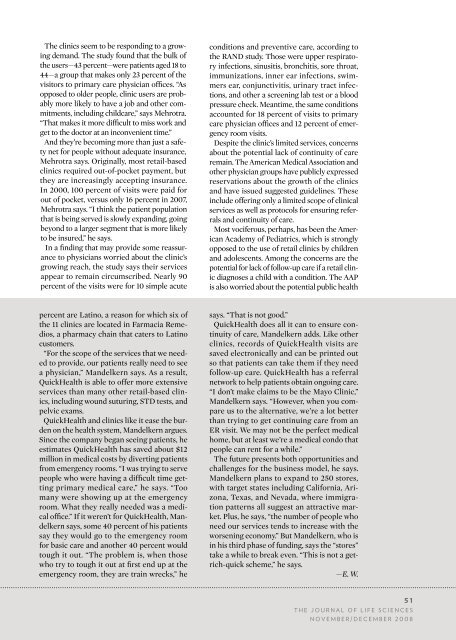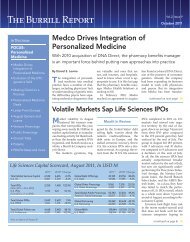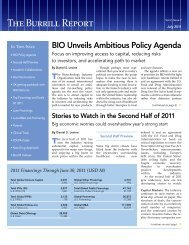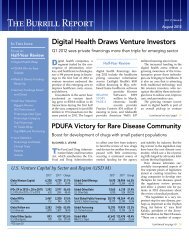The Sex Issue - The Burrill Report
The Sex Issue - The Burrill Report
The Sex Issue - The Burrill Report
You also want an ePaper? Increase the reach of your titles
YUMPU automatically turns print PDFs into web optimized ePapers that Google loves.
<strong>The</strong> clinics seem to be responding to a growing<br />
demand. <strong>The</strong> study found that the bulk of<br />
the users—43 percent—were patients aged 18 to<br />
44—a group that makes only 23 percent of the<br />
visitors to primary care physician offices. “As<br />
opposed to older people, clinic users are probably<br />
more likely to have a job and other commitments,<br />
including childcare,” says Mehrotra.<br />
“That makes it more difficult to miss work and<br />
get to the doctor at an inconvenient time.”<br />
And they’re becoming more than just a safety<br />
net for people without adequate insurance,<br />
Mehrotra says. Originally, most retail-based<br />
clinics required out-of-pocket payment, but<br />
they are increasingly accepting insurance.<br />
In 2000, 100 percent of visits were paid for<br />
out of pocket, versus only 16 percent in 2007,<br />
Mehrotra says. “I think the patient population<br />
that is being served is slowly expanding, going<br />
beyond to a larger segment that is more likely<br />
to be insured,” he says.<br />
In a finding that may provide some reassurance<br />
to physicians worried about the clinic’s<br />
growing reach, the study says their services<br />
appear to remain circumscribed. Nearly 90<br />
percent of the visits were for 10 simple acute<br />
conditions and preventive care, according to<br />
the RAND study. Those were upper respiratory<br />
infections, sinusitis, bronchitis, sore throat,<br />
immunizations, inner ear infections, swimmers<br />
ear, conjunctivitis, urinary tract infections,<br />
and other a screening lab test or a blood<br />
pressure check. Meantime, the same conditions<br />
accounted for 18 percent of visits to primary<br />
care physician offices and 12 percent of emergency<br />
room visits.<br />
Despite the clinic’s limited services, concerns<br />
about the potential lack of continuity of care<br />
remain. <strong>The</strong> American Medical Association and<br />
other physician groups have publicly expressed<br />
reservations about the growth of the clinics<br />
and have issued suggested guidelines. <strong>The</strong>se<br />
include offering only a limited scope of clinical<br />
services as well as protocols for ensuring referrals<br />
and continuity of care.<br />
Most vociferous, perhaps, has been the American<br />
Academy of Pediatrics, which is strongly<br />
opposed to the use of retail clinics by children<br />
and adolescents. Among the concerns are the<br />
potential for lack of follow-up care if a retail clinic<br />
diagnoses a child with a condition. <strong>The</strong> AAP<br />
is also worried about the potential public health<br />
percent are Latino, a reason for which six of<br />
the 11 clinics are located in Farmacia Remedios,<br />
a pharmacy chain that caters to Latino<br />
customers.<br />
“For the scope of the services that we needed<br />
to provide, our patients really need to see<br />
a physician,” Mandelkern says. As a result,<br />
QuickHealth is able to offer more extensive<br />
services than many other retail-based clinics,<br />
including wound suturing, STD tests, and<br />
pelvic exams.<br />
QuickHealth and clinics like it ease the burden<br />
on the health system, Mandelkern argues.<br />
Since the company began seeing patients, he<br />
estimates QuickHealth has saved about $12<br />
million in medical costs by diverting patients<br />
from emergency rooms. “I was trying to serve<br />
people who were having a difficult time getting<br />
primary medical care,” he says. “Too<br />
many were showing up at the emergency<br />
room. What they really needed was a medical<br />
office.” If it weren’t for QuickHealth, Mandelkern<br />
says, some 40 percent of his patients<br />
say they would go to the emergency room<br />
for basic care and another 40 percent would<br />
tough it out. “<strong>The</strong> problem is, when those<br />
who try to tough it out at first end up at the<br />
emergency room, they are train wrecks,” he<br />
says. “That is not good.”<br />
QuickHealth does all it can to ensure continuity<br />
of care, Mandelkern adds. Like other<br />
clinics, records of QuickHealth visits are<br />
saved electronically and can be printed out<br />
so that patients can take them if they need<br />
follow-up care. QuickHealth has a referral<br />
network to help patients obtain ongoing care.<br />
“I don’t make claims to be the Mayo Clinic,”<br />
Mandelkern says. “However, when you compare<br />
us to the alternative, we’re a lot better<br />
than trying to get continuing care from an<br />
ER visit. We may not be the perfect medical<br />
home, but at least we’re a medical condo that<br />
people can rent for a while.”<br />
<strong>The</strong> future presents both opportunities and<br />
challenges for the business model, he says.<br />
Mandelkern plans to expand to 250 stores,<br />
with target states including California, Arizona,<br />
Texas, and Nevada, where immigration<br />
patterns all suggest an attractive market.<br />
Plus, he says, “the number of people who<br />
need our services tends to increase with the<br />
worsening economy.” But Mandelkern, who is<br />
in his third phase of funding, says the “stores”<br />
take a while to break even. “This is not a getrich-quick<br />
scheme,” he says.<br />
—E. W.<br />
5 1<br />
<strong>The</strong> Journal of Life Sciences<br />
november/december 2008












